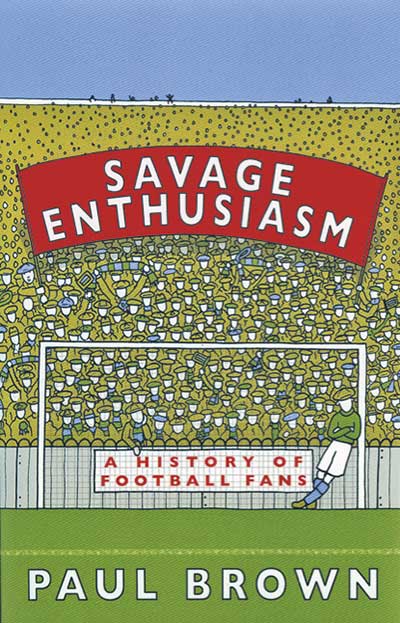
Goal Post, £12.99
Reviewed by Simon Tindall
From WSC 367, September 2017
Buy the book
There is a TV documentary-maker out there who could seize on Savage Enthusiasm as the basis of a script for a four-part series on the history of football fans. It covers all the obvious touch points – the White Horse Cup final, Hillsborough, Nick Hornby, working classes priced out – to get a grazing television audience nodding at familiar topics. But the real enthusiast, the fan’s fan if you like, would be left awaiting a significant revelation.
Paul Brown has taken on a huge subject, much bigger than it looks at first, and, in order to manage it, has narrowed the perspective to that of the everyman follower of big English clubs. Scotland appears in the context of disaster and hooliganism, the lower divisions, non-League and local league hardly at all. He leads us on a chronological path illuminated by examples from the most ancient of times to the internet age.
Impatient readers could happily join the trek at the second chapter in 1860 thus avoiding some tenuous links between football fans and young boys on ancient Greek vases. Savage Enthusiasm hits its stride in the Victorian era which is Brown’s speciality. He curates the Goal Post website dedicated to pre-First World War football. The use of contemporary reports strengthens the stories, revealing for example the motive for a riot in the Burnley v Blackburn derby of 1890 when the referee was the brother of the Rovers goalkeeper.
Solid research into small matters abounds. When did rosettes and club songs come in? How many minutes’ silences did there used to be (there’s more now in a typical season than there were for half a century)? What did it cost to get into a match? These are great snippets but a few of the broader assertions are questionable. People supported clubs outside their locality before the 1980s, people change the club they support and there is a leftist orthodoxy throughout. When he writes of the fans of 1990 “it would be easy to overstate the influence of E on football” there is a cheer that Brown sees the generalisations of those self-aggrandising cultural critics of that era for what they were.
He makes the excellent point that it was clubs that were the gateway from an appreciation of the game to a fanaticism for it. It would have been enlightening to have dwelt more on the motivations and satisfactions for this crucial relationship in the sport’s success. Londoners apparently were happy to support any London club in the FA Cup finals of 1901 (Spurs) and 1923 (West Ham) but it’s doubtful the same feelings would apply today. Why?
For younger followers and football activists Savage Enthusiasm is a very decent, impeccably sourced, primer on what has happened to fans down the ages but raises deeper questions on why they embarked on the journey and how they felt about it afterwards. It’s a work worth building on.